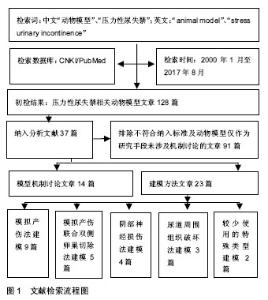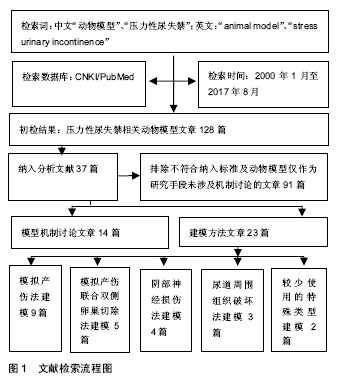| [1] Abrams P, Cardozo L, Fall M, et al. The standardisation of terminology in lower urinary tract function: report from the standardisation sub-committee of the International Continence Society. Urology. 2003;61(1):37-49.[2] Kobashi KC, Albo ME, Dmochowski RR, et al. Surgical Treatment of Female Stress Urinary Incontinence (SUI): AUA/SUFU Guideline. 2017. http://www.auanet.org/guidelines/stress-urinary-incontinence-(sui)-new-(aua/sufu-guideline-2017). 2017-05-20. [3] Sinclair A J, Ramsay I N. The psychosocial impact of urinary incontinence in women. Obstetrician Gynaecologist. 2011;13(3): 143-148.[4] 郑慧敏,徐世芬,尹平,等.电针治疗轻中度女性压力性尿失禁的近远期疗效观察[J].世界中西医结合杂志, 2015,10(2):191-193.[5] Liu Z, Liu Y, Xu H, et al. Effect of Electroacupuncture on Urinary Leakage Among Women With Stress Urinary Incontinence: A Randomized Clinical Trial. JAMA. 2017; 317(24):2493-2501.[6] Hijaz A, Daneshgari F, Sievert KD, et al. Animal models of female stress urinary incontinence. J Urol. 2008;179(6): 2103-2110. [7] Jiang HH, Damaser MS. Animal models of stress urinary incontinence. Handb Exp Pharmacol. 2011;(202):45-67.[8] Herrera-Imbroda B, Lara MF, Izeta A, et al. Stress urinary incontinence animal models as a tool to study cell-based regenerative therapies targeting the urethral sphincter. Adv Drug Deliv Rev. 2015;82-83: 106-116. [9] Burdzińska A, Crayton R, Dybowski B, et al. Urethral distension as a novel method to simulate sphincter insufficiency in the porcine animal model. Int J Urol. 2012; 19(7):676-682.[10] Gill BC, Damaser MS, Vasavada SP, et al. Stress incontinence in the era of regenerative medicine: reviewing the importance of the pudendal nerve. J Urol. 2013;190(1): 22-28. [11] Koike Y, Furuta A, Suzuki Y, et al. Pathophysiology of urinary incontinence in murine models. Int J Urol. 2013;20(1):64-71. [12] Sajadi KP, Gill BC, Damaser MS. Neurogenic aspects of stress urinary incontinence. Curr Opin Obstet Gynecol. 2010;22(5):425-429. [13] Baek M, Paick SH, Jeong SJ, et al. Urodynamic and histological changes in a sterile rabbit vesicoureteral reflux model. J Korean Med Sci. 2010;25(9):1352-1358. [14] Gill BC, Moore C, Damaser MS. Postpartum stress urinary incontinence: lessons from animal models. Expert Rev Obstet Gynecol. 2010;5(5):567-580.[15] Goldberg RP, Kwon C, Gandhi S, et al. Urinary incontinence among mothers of multiples: the protective effect of cesarean delivery. Am J Obstet Gynecol. 2003;188(6):1447-1450; discussion 1450-1453.[16] Pan HQ, Kerns JM, Lin DL, et al. Increased duration of simulated childbirth injuries results in increased time to recovery. Am J Physiol Regul Integr Comp Physiol. 2007; 292(4):R1738-1744. [17] Phull HS, Pan HQ, Butler RS, et al. Vulnerability of continence structures to injury by simulated childbirth. Am J Physiol Renal Physiol. 2011;301(3):F641-649. [18] Woo LL, Hijaz A, Pan HQ, et al. Simulated childbirth injuries in an inbred rat strain. Neurourol Urodyn. 2009;28(4):356-361. [19] Boncher N, Vricella G, Kavran M, et al. Setting a new standard: updating the vaginal distention translational model for stress urinary incontinence. Neurourol Urodyn. 2012;31(1):190-194. [20] Sievert KD, Bakircioglu ME, Tsai T, et al. The effect of labor and/or ovariectomy on rodent continence mechanism--the neuronal changes. World J Urol. 2004;22(4):244-250.[21] Vricella GJ, Tao M, Altuntas CZ, et al. Expression of monocyte chemotactic protein 3 following simulated birth trauma in a murine model of obesity. Urology. 2010;76(6):1517.e12-17. [22] 汤剑明,洪莉,刘成,等.压力性尿失禁小鼠模型的建立及效果评价[J].中华妇幼临床医学杂志(电子版),2016,12(5):540-546.[23] Kane DD, Kerns JM, Lin DL, et al. Early structural effects of oestrogen on pudendal nerve regeneration in the rat. BJU Int. 2004;93(6): 870-878.[24] Qiang F, Guo-long L. Comparative study of three rat models of stress urinary incontinence. Bosn J Basic Med Sci. 2011; 11(2):87-90.[25] Sievert KD, Emre Bakircioglu M, Tsai T, et al. The effect of simulated birth trauma and/or ovariectomy on rodent continence mechanism. Part I: functional and structural change. J Urol. 2001;166(1):311-317.[26] Resplande J, Gholami SS, Graziottin TM, et al. Long-term effect of ovariectomy and simulated birth trauma on the lower urinary tract of female rats. J Urol. 2002;168(1):323-330.[27] Kuo HC. Effects of vaginal trauma and oophorectomy on the continence mechanism in rats. Urol Int. 2002;69(1):36-41.[28] Damaser MS, Broxton KC, Ferguson C, et al. Functional and neuroanastomical effects of vaginal distension and pudendal nerve crush in the female rat. J Urol. 2003;170(3):1027-1031.[29] 王皓羽,杜小文,徐剑炜,等.压力性尿失禁动物模型的建立及效果评价[J].中国组织工程研究与临床康复, 2010,14(11): 1959-1962.[30] Ahn H, Lin DL, Esparza N, et al. Short-term timecourse of bilateral pudendal nerve injury on leak-point pressure in female rats. J Rehabil Res Dev. 2005;42(1):109-114.[31] Peng CW, Chen JJ, Chang HY, et al. External urethral sphincter activity in a rat model of pudendal nerve injury. Neurourol Urodyn. 2006;25(4):388-396.[32] Chermansky CJ, Cannon TW, Torimoto K, et al. A model of intrinsic sphincteric deficiency in the rat: electrocauterization. Neurourol Urodyn. 2004;23(2):166-171.[33] Hong SH, Piao S, Kim IG, et al. Comparison of three types of stress urinary incontinence rat models: electrocauterization, pudendal denervation, and vaginal distension. Urology. 2013; 81(2):465.e1-6. [34] Kefer JC, Liu G, Daneshgari F. Pubo-urethral ligament injury causes long-term stress urinary incontinence in female rats: an animal model of the integral theory. J Urol. 2009;181(1): 397-400. [35] Takahashi S, Chen Q, Ogushi T, et al. Periurethral injection of sustained release basic fibroblast growth factor improves sphincteric contractility of the rat urethra denervated by botulinum-a toxin. J Urol. 2006;176(2):819-823.[36] Kwon D, Kim Y, Pruchnic R, et al. Periurethral cellular injection: comparison of muscle-derived progenitor cells and fibroblasts with regard to efficacy and tissue contractility in an animal model of stress urinary incontinence. Urology. 2006; 68(2):449-454.[37] Yoshimura N, Miyazato M. Neurophysiology and therapeutic receptor targets for stress urinary incontinence. Int J Urol. 2012;19(6):524-537. |



